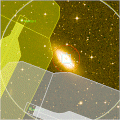 |
OT Release Notes: Limberlost
|
The Limberlost version of the Observing Tool was publicly
released on 10 July 2002. Summarised below are the most significant changes
from the previous public release (OT2002A.11). There is extensive web
documentation that describes the new and modified features and an updated
tutorial.
- New instrument components and instrument iterators
- T-ReCS component and iterator added. The position editor supports
visualisation of primary science beam and chop/nod offset beams.
The offset beams can be toggled off (TPE view menu) to simplify the view.
Rotation of the instrument angle is separate from the chop angle. The nod
offset is forced to be the same (and opposite) of the chop throw. A toggle
(TPE view menu) allows the offset positions of PWFS to be viewed
separately.
- Phoenix component added. There is no iterator. Although a visitor
instrument, so no direct control of the instrument from the OT, it will be
used for Phase II in semester 2002B.
- Acquisition Camera component and iterator added.
- Altair component added. There is no iterator. To be used in 2002B for
commissioning. Can be used in conjunction with another instrument
component e.g. NIRI. Support for
Altair AO guide stars added (to target component and TPE). TPE button
optionally shows AO guide star patrol field.
- GPOL iterator added. There is no static component. To be used in 2002B
for commissioning. Must be used in conjunction with an instrument
component e.g. NIRI.
- Modified instrument components and iterators
- GMOS iterator added. Option for GMOS on up-looking or side-looking port
(affects OIWFS patrol field). Support for nod & shuffle (from semester
2003A). IFU visualisation modified so that selected IFU appears at the target
coordinates, rather than offset from the base position. The PWFS and OIWFS
patrol fields are offset from the target position (i.e. they are drawn
correctly around the pointing axis). Science area overlay correctly
represents available FOV.
- NIRI beamsplitter added as separate option from camera (e.g. to allow use
of f/6 plate scale with OIWFS and f/14 beamsplitter). Field of view now
shown correctly, compared with previous internal releases. Support for selecting polarisation components
(Wollaston, polarisation masks) but not yet included in TPE visualisation. Control of detector readout mode and well depth added.
Slit lengths and names updated. Regions of interest added. Filters combined
into single list.
- GCAL options modify to correspond to hardware (added IR grey body high/low and
shutter open/closed). Configurations now correctly exported and imported in XML
files (bug
fix).
- Other user interface features
- Assignment of guide star to steps in offset iterator can be changed more
easily. Multiple steps (either contiguous or disjoint sections) can be selected:
shift+click to select a range of
steps; control+click to select specific multiple steps. Selected multiple
steps can moved within sequence as for individual steps.
- OT (database) browser allows searching of all observations in (local) database
(use File menu). Search by program parameters, target range or instrument
characteristics. Query results can be sorted (click on column title) and
columns for display can be configured. Double click on observation in query
results to open it in Science Program editor. (To be used by Gemini staff
for observation selection during execution).
- Observations may now contain arbitrary number of iterators (e.g. multiple
offset and repeat iterators). These do not need to be in a single-branch
hierarchy.
- Program chooser now includes Gemini Program ID (if available) and last
update as well as the program title. The date of last update is modified
each time program details are changed.
- Toggle between read-only and edit modes added (button in top right of
Science Program editor).
- Entire (local) database of Science Programs can be exported or imported to
XML files. This is the prefer migration option for local and observatory
databases when installing new OT.
- Other features
- Uses Java 1.4. Note that this means the Java patches are different from
previous releases. The README file in the Solaris version points to the Sun
URL with patches and instructions.
- Compatibility with public PIT (2002B) re-established. Phase I proposals
with or without TAC information can be loaded. Target brightness is migrated
correctly.
- Bug fixed when editing titles of observations in groups.
- Random offset item in offset iterator now draws points from distribution
in square pattern, previously was 2D Gaussian distribution.
- Many underlying infrastructure changes and bug fixes not visible in user interface.
![[Science Operations home]](../generic-images/sciopshomebtn.gif)
![[Observing Tool home]](othomebtn.gif)
Last update: Phil Puxley
11 July 2002

